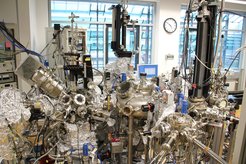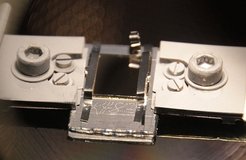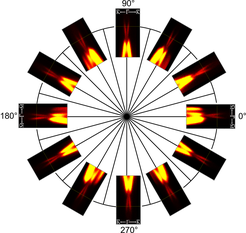Press Release: Intrinsic conduction through topological surface states of Bi2Te3
Topological insulators (TI) are a new class of materials with exotic properties which have been predicted by theory just a few years ago. Unfortunately, defects in the crystal structure as well as impurities or oxidation of the surface in air often prevent an accurate experimental study of these materials, and thus hamper their development with respect to technical applications. Scientists at the MPI CPfS Dresden, in collaboration with the University of British Columbia (Canada), recently managed to circumvent these difficulties.
Topological insulators (TI) are a new class of materials with exotic properties which have been predicted by theory just a few years ago. The term "topological insulators" represents compounds which are insulators in the bulk, but simultaneously the bulk unavoidably generates a metallic surface due to quantum effects. Because of their great potential for novel applications, such as highly efficient memory chips, these materials are currently being investigated intensely. Moreover, in these compounds the existence and observability of fundamentally new quantum particles, for example the so-called Majorana fermions, were predicted. Unfortunately, defects in the crystal structure as well as impurities or oxidation of the surface in air often prevent an accurate experimental study of these materials, and thus hamper their development with respect to technical applications.
Scientists at the MPI CPfS Dresden, in collaboration with the University of British Columbia (Canada), recently managed to circumvent these difficulties. The Dresden researchers prepared few nanometers (billionths of a meter) thin films of the TI- material Bi2Te3 on a substrat of BaF2, carefully optimizing their Bi2Te3 samples (see Fig. 1). To prevent contamination or oxidation of the surface by air, the preparation and all subsequent investigations of the samples were carried out under ultrahigh vacuum conditions. The physicists at CPfS have designed a so far unique device specially suited for such experiments (see Fig. 2). For a detailed understanding of the electronic structure of the Bi2Te3 film, angle-resolved photoelectron spectra (ARPES) were recorded (see Fig. 3). This is accomplished by illuminating the surface of the sample with high energy light and a subsequent analysis of the energy of the electrons emitted in different directions. The spectra recorded by the CPfS physicists (see Fig. 3) provide clear evidence of the excellent quality of their Bi2Te3 films, and thus demonstrate a feasible approach for the further development of this class of materials. For future applications, the protection of the films, prepared in ultrahigh vacuum, by appropriate cover layers from contamination in air remains a challenging task.

Ultra-high-vacuum system at the MPI CPfS Dresden. The complex, unique construction combines sample preparation and characterization, e.g. by means of angle-resolved photoelectron spectroscopy, as well as transport measurements, without leaving the high-purity UHV conditions. This way, contamination of the sample surface between the various measurements can be avoided.




